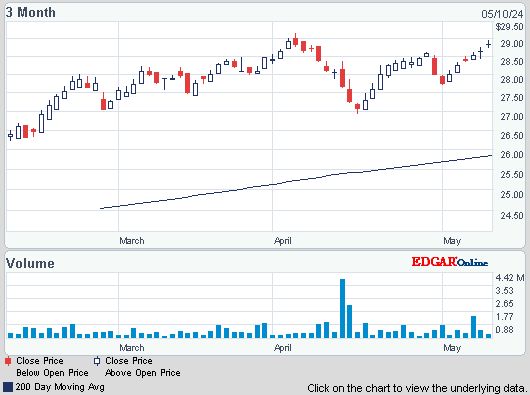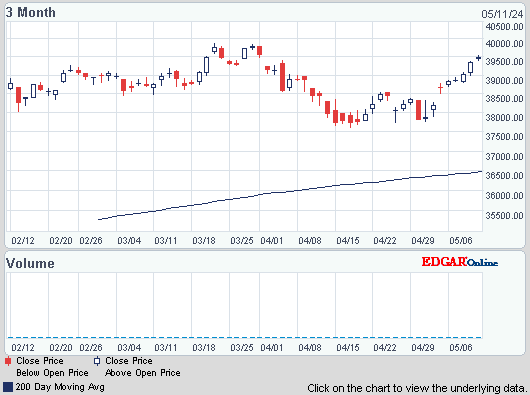Dow slipped 32, decliners over advancers 3-2 & NAZ was off 15. The Financial Index fell 1+ to the 194s.
The MLP index dropped 1 to the 368s & the REIT index fell 1 to 255. Junk bond funds inched higher & Treasuries rose for the first time in 3 days after data showed more Americans than forecast filed claims for jobless benefits. Oil tumbled below $80 a barrel for the first time in 8 months on weak economic data that increased concern that demand will slow with supplies are at the highest level in 22 years. Gold sank below $1600 & may be heading for its recent lows around $1500, it is not attracting investor interest as a safe haven.

Photo: Yahoo
The number of Americans filing new claims for unemployment benefits was little changed last week, according to the Labor Dept, suggesting the labor market was struggling to regain momentum. Initial claims for benefits slipped 2K to 387K. The prior week's figure was revised up to 389K from the previously reported 386K. The forecast was for claims falling to 380K. The 4-week moving average for new claims increased 3K to 386K, the highest level since early Dec. Claims rose 15K between the May & Jun survey periods. Labor market weakness prompted the Federal Reserve to ease monetary policy further by extending a program to re-weight bonds it already holds toward longer maturities to hold down borrowing costs. Much of the recent weakness in the labor market has been due to a decline in hiring, rather than increased layoffs. New applications for unemployment benefits have barely budged since Apr. The number still receiving benefits was unchanged at 3.3M & the number on extended benefits fell 24K to 110K, as more states lost eligibility for extended benefits for the long-term unemployed. Only 6 states & DC are offering extended benefits. 5.83M were claiming unemployment benefits under all programs, down 1K from the previous week. The jobless claims data is looking glum again.
More Americans Than Forecast File for Jobless Benefits
Photo: Yahoo
Spain's borrowing costs hit a new euro era high at a debt auction today, a few hours before it is expected to shed light on the dire state of its weaker banks & possibly make a formal request for an EU rescue. The auction proved the Spanish Treasury can still borrow on intl markets, albeit at a high cost, & it made the best of solid demand by selling €2.2B ($2.8B) in bonds, above the targeted amount. "We want to emphasize the strong demand despite the current situation on the markets," an Economy Ministry said. However, the rocketing yields contrasted with France's sale of bonds maturing in 2014 for just 0.54%, as concerns that Spain might have to take a full sovereign bailout meant that intl investors are opting for less risky debt. Madrid paid 4.706% for the same maturity. Data shows intl investors are steering clear of Spain & have left the troubled domestic banks to buy up gov bonds. Spain may make a formal request for up to €100B in aid at a Luxembourg meeting of euro zone finance ministers, who already approved the plan informally earlier this month. The demand would follow the release of the results of an independent audit of the Spanish banks, which have been hammered by the effects of a property crash & the recession. Banking sources believe this will say the lenders need to raise a further €60-70B to improve their capital position. This situation keeps going from bad to worse day by day.
Spain Pays New Record for Medium-Term Debt

Photo: Bloomberg
Sales of previously owned homes in the US declined in May, indicating an uneven recovery in residential real estate. Purchases of existing properties dropped 1.5% to a 4.55M annual rate last month, according to the National Association of Realtors, just below the forecast of 4.57M. Estimates ranged from 4.4M-4.73M. Weak employment gains & limited access to credit are restraining a housing industry that’s been supported by record-low borrowing costs & cheaper properties that are drawing investors. The figures underscore Ben Bernanke's comments that the economy is failing to get a boost from a typical real-estate recovery. Macro economic data is continuing to take a bite out of the housing recovery.
Sales of Existing U.S. Homes Fell in May to 4.55 Million Rate
Markets aren't going anywhere as has been the case all week. Jobless claims & housing sales are not encouraging. Europe debt problems just lumber on. Q2 is winding down & with the sluggish macro data, earnings estimates are being reduced. Dow fell below 13K 6 weeks ago & climbing back over seems to be a long way off.

The MLP index dropped 1 to the 368s & the REIT index fell 1 to 255. Junk bond funds inched higher & Treasuries rose for the first time in 3 days after data showed more Americans than forecast filed claims for jobless benefits. Oil tumbled below $80 a barrel for the first time in 8 months on weak economic data that increased concern that demand will slow with supplies are at the highest level in 22 years. Gold sank below $1600 & may be heading for its recent lows around $1500, it is not attracting investor interest as a safe haven.
AMJ (Alerian MLP Index tracking fund)
Treasury yields:
U.S. 3-month | 0.076% | |
U.S. 2-year | 0.298% | |
U.S. 10-year | 1.613% |
| CLQ12.NYM | Crude Oil Aug 12 | 80.88 |
| GCM12.CMX | Gold Jun 12 | 1,581.70 |
Get the latest daily market update below:
Photo: Yahoo
The number of Americans filing new claims for unemployment benefits was little changed last week, according to the Labor Dept, suggesting the labor market was struggling to regain momentum. Initial claims for benefits slipped 2K to 387K. The prior week's figure was revised up to 389K from the previously reported 386K. The forecast was for claims falling to 380K. The 4-week moving average for new claims increased 3K to 386K, the highest level since early Dec. Claims rose 15K between the May & Jun survey periods. Labor market weakness prompted the Federal Reserve to ease monetary policy further by extending a program to re-weight bonds it already holds toward longer maturities to hold down borrowing costs. Much of the recent weakness in the labor market has been due to a decline in hiring, rather than increased layoffs. New applications for unemployment benefits have barely budged since Apr. The number still receiving benefits was unchanged at 3.3M & the number on extended benefits fell 24K to 110K, as more states lost eligibility for extended benefits for the long-term unemployed. Only 6 states & DC are offering extended benefits. 5.83M were claiming unemployment benefits under all programs, down 1K from the previous week. The jobless claims data is looking glum again.
More Americans Than Forecast File for Jobless Benefits
Photo: Yahoo
Spain's borrowing costs hit a new euro era high at a debt auction today, a few hours before it is expected to shed light on the dire state of its weaker banks & possibly make a formal request for an EU rescue. The auction proved the Spanish Treasury can still borrow on intl markets, albeit at a high cost, & it made the best of solid demand by selling €2.2B ($2.8B) in bonds, above the targeted amount. "We want to emphasize the strong demand despite the current situation on the markets," an Economy Ministry said. However, the rocketing yields contrasted with France's sale of bonds maturing in 2014 for just 0.54%, as concerns that Spain might have to take a full sovereign bailout meant that intl investors are opting for less risky debt. Madrid paid 4.706% for the same maturity. Data shows intl investors are steering clear of Spain & have left the troubled domestic banks to buy up gov bonds. Spain may make a formal request for up to €100B in aid at a Luxembourg meeting of euro zone finance ministers, who already approved the plan informally earlier this month. The demand would follow the release of the results of an independent audit of the Spanish banks, which have been hammered by the effects of a property crash & the recession. Banking sources believe this will say the lenders need to raise a further €60-70B to improve their capital position. This situation keeps going from bad to worse day by day.
Spain Pays New Record for Medium-Term Debt

Sales of previously owned homes in the US declined in May, indicating an uneven recovery in residential real estate. Purchases of existing properties dropped 1.5% to a 4.55M annual rate last month, according to the National Association of Realtors, just below the forecast of 4.57M. Estimates ranged from 4.4M-4.73M. Weak employment gains & limited access to credit are restraining a housing industry that’s been supported by record-low borrowing costs & cheaper properties that are drawing investors. The figures underscore Ben Bernanke's comments that the economy is failing to get a boost from a typical real-estate recovery. Macro economic data is continuing to take a bite out of the housing recovery.
Sales of Existing U.S. Homes Fell in May to 4.55 Million Rate
Markets aren't going anywhere as has been the case all week. Jobless claims & housing sales are not encouraging. Europe debt problems just lumber on. Q2 is winding down & with the sluggish macro data, earnings estimates are being reduced. Dow fell below 13K 6 weeks ago & climbing back over seems to be a long way off.
Dow Jones Industrials
Get your favorite symbols' Trend Analysis TODAY!




No comments:
Post a Comment